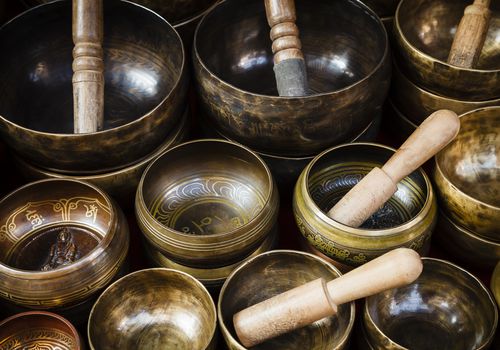Taken From Buddhist Temples to Being Highly Demanded Globally: The Journey of Tibetan Singing Bowls

Cover : shantibowl.com
Originating from China, Tibetan singing bowls are increasing in demand thanks to the new age spirituality. Their original names are ‘standing bells’ or ‘resting bells’. However, most of them come from Tibet, where a lot of important buddhist monasteries reside, therefore they are mostly known as ‘Tibetan Singing Bowls’ all around the world. They are slightly inverted metal bowls that are variant in size and they usually come along with sticks to make particular sounds. The singing bowls have been used pretty much within buddhist and taoist practices for hundreds of years. Their main usages are for meditation and chanting prayers .

Single singing bowl with a strike, shantibowl.com
Their usages have been applied in the music industry since they started to be exported to Western countries. Henry Wolff and Nancy Hennings introduced these singing bowls to the musicians with their album which is called ‘Tibetan Bells’ in 1972. The album itself is a new-age spiritualist album aiming to make the listeners go on a spiritual journey with sounds of the bowls .
Their modern usages include alternative medicine as well. Today, it is believed that the sounds of the Tibetan singing bowls have healing properties. Because each bowl is attuned to a certain frequency that are musical notes, they are attuning our auras and our home to the same frequencies. As a result, our home and/or our aura is purified and cleansed. The bowls’ vibrating in a certain frequency is believed that it affects its surroundings’ frequency as well. The bowls’ features are also reckoned to heal the ‘chakras’ which are the seven energy centers within our spiritual body known as the aura. Working on chakras is an Indian tradition and the new age spirituality combines these two different practices.

verywellmind.com
How do the singing bowls help the chakras heal? The process is pretty simple. It is believed that striking a bowl with a certain frequency is matched with each individual chakra, the vibrations of the sound is supposed to heal, cleanse and activate the chakras. According to this belief, there are seven chakras with main different vibrations as there are seven essential notes (do, re, mi, fa, sol, la and si). Each chakra starts from the base to the crown chakra, and they are matched with the musical notes vibrationally. Therefore, striking each frequency with the same musical note may help to unblock and heal our chakras.
These singing bowls are also utilized in sound bath sessions. In sound bath sessions, the pre-agreed principal is the same principal that we discussed above. The vibrations from the sound of these singing bowls are clearing and spiritually healing by attuning our vibrations. The ‘bathing’ aspect here comes with being exposed to these vibrations in an extensive amount by listening to them for a certain period of time. During this time period of sound bathing, meditation and relaxing are usually done to aid further treatments as these singing bowls are also used to help people focus, reduce stress and relieve anxiety.
Whether one believes in these practices or spiritualistic views over the Tibetan bowls or not, these bowls are a ‘striking’ experience for most people. Their popularity globally originated mostly from these new-age beliefs. They are used in music as well, but especially to bring healing to its listener. A much more modern and recent example for this can be the lovely R&B singer Jhené Aiko. She is particularly known for using Tibetan singing bowls in her songs for healing purposes.

Jhené Aiko , singersroom.com
Resources
- https://en.wikipedia.org/wiki/Standing_bell
- https://www.verywellmind.com/tibetan-singing-bowls-for-healing-89828
- https://www.shantibowl.com/blogs/blog/dangers-of-singing-bowls
- https://www.shantibowl.com/blogs/blog/guide-to-sound-baths-and-sound-bathing-therapy
- https://singersroom.com/content/2019-11-27/7-reasons-why-jhene-aiko-is-our-spirit-songstress/8/






